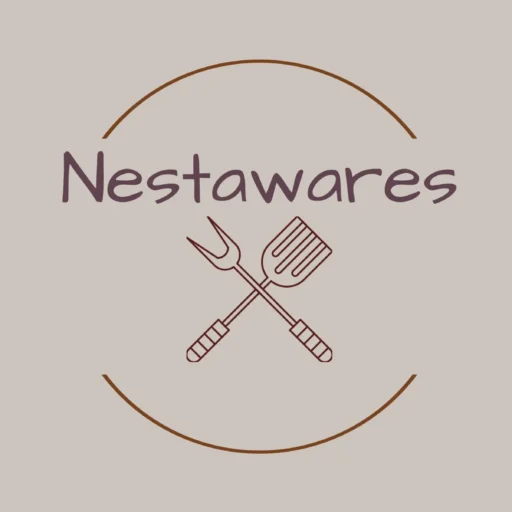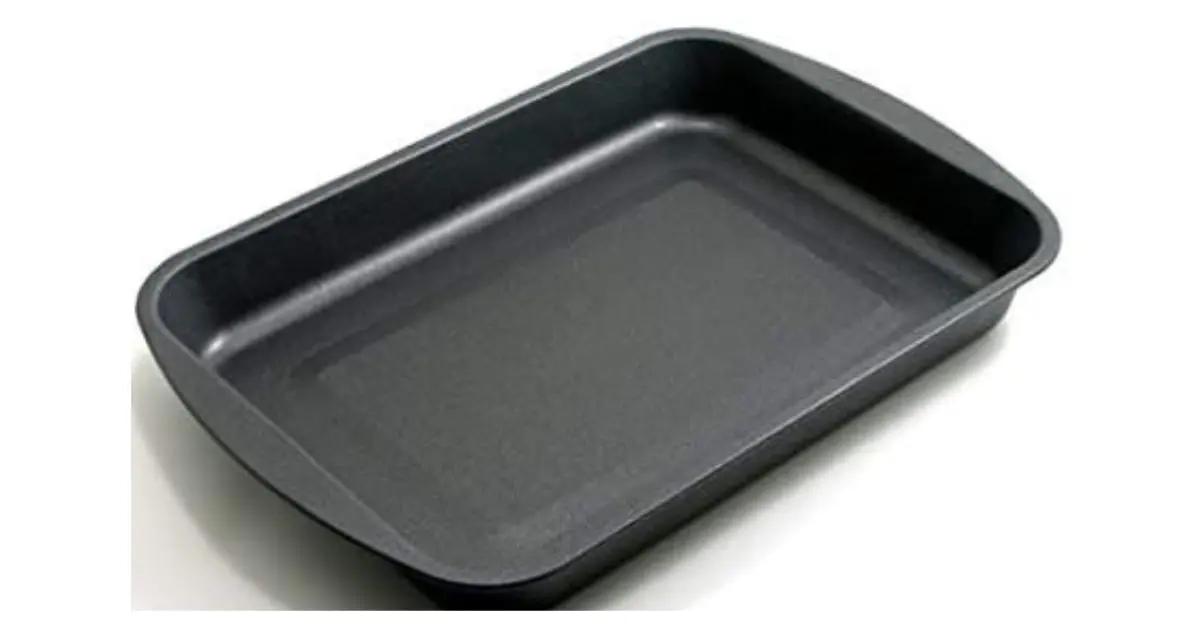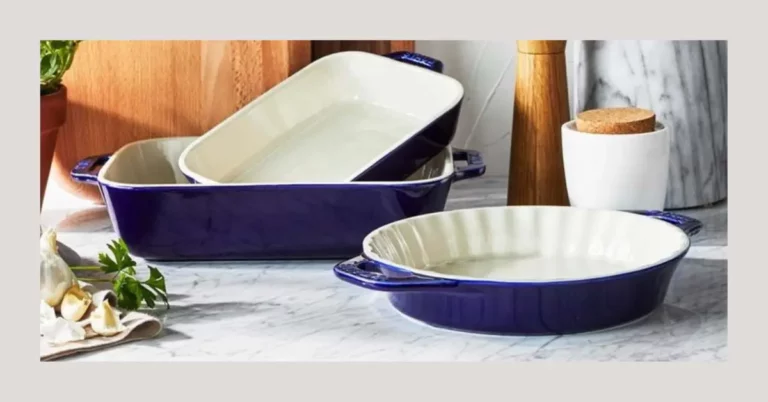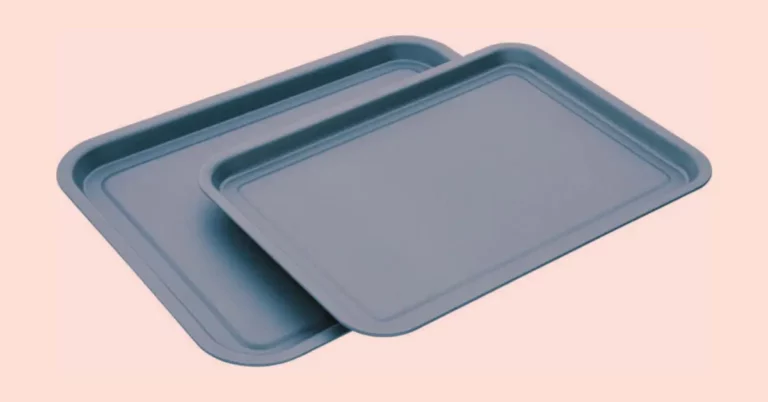Disclosure: As an Amazon associate, I may earn from qualifying purchases
Continuing from our previous article on Teflon baking pans, this post will be answering even more of your questions surrounding non-stick bakeware. In our previous article, we explored the wonders of Teflon coating, its history, usage, and healthier alternatives.
Now, get ready to dive deeper as we continue our quest to answer more burning questions surrounding professional baking pans. From finding suitable replacements for Teflon to comparing different materials and addressing health concerns, this article has you covered.
While Teflon baking pans have long been favored for their non-stick properties, it’s natural to wonder about the alternatives available in the realm of professional baking. We’ll delve into a range of options, from silicone and glass to anodized aluminum and carbon steel, providing you with insights into their benefits and suitability for various baking tasks.
You can find out more on professional-grade bakeware and get the perfect replacement for your Teflon pans, ensuring exceptional results in the kitchen.
Comparing Teflon pans with bakeware made from other different materials is an essential aspect of making informed choices for your culinary adventures. We’ll discuss the advantages and disadvantages of each material, examining their heat conductivity, durability, and overall performance.
Whether you’re seeking precise temperature control, superior browning, or exceptional durability, our insights will help you navigate the vast landscape of professional baking pans.
Health and safety are paramount when it comes to choosing bakeware, and we understand the concerns surrounding Teflon coating. We’ll address the potential health issues associated with Teflon pans, providing you with balanced information to make he right choices when it comes to kitchenware.
Furthermore, we’ll explore the safety features offered by alternative materials, ensuring that your baking endeavors prioritize your well-being and peace of mind.
The benefits of professional baking pans extend beyond material considerations. The advantages of investing in high-quality bakeware includes superior heat distribution, enhanced durability, and exquisite presentation.
From achieving impeccable results with delicate pastries to showcasing culinary masterpieces with confidence, professional-grade baking pans are the key to taking your creations to new heights.
We’ve covered it all – from suitable replacements for Teflon pans to material comparisons, health considerations, and the remarkable benefits of professional-grade bakeware. Get ready to embrace a world of precision, performance, and delectable creations as we answer some of the most pressing questions on Teflon baking pans.
Now, get ready to dive deeper as we continue our quest to answer more burning questions surrounding professional baking pans. From finding suitable replacements for Teflon to comparing different materials and addressing health concerns, this article has you covered.
While Teflon baking pans have long been favored for their non-stick properties, it’s natural to wonder about the alternatives available in the realm of professional baking. We’ll delve into a range of options, from silicone and glass to anodized aluminum and carbon steel, providing you with insights into their benefits and suitability for various baking tasks.
You can find out more on professional-grade bakeware and get the perfect replacement for your Teflon pans, ensuring exceptional results in the kitchen.
Comparing Teflon pans with bakeware made from other different materials is an essential aspect of making informed choices for your culinary adventures. We’ll discuss the advantages and disadvantages of each material, examining their heat conductivity, durability, and overall performance.
Whether you’re seeking precise temperature control, superior browning, or exceptional durability, our insights will help you navigate the vast landscape of professional baking pans.
Health and safety are paramount when it comes to choosing bakeware, and we understand the concerns surrounding Teflon coating. We’ll address the potential health issues associated with Teflon pans, providing you with balanced information to make he right choices when it comes to kitchenware.
Furthermore, we’ll explore the safety features offered by alternative materials, ensuring that your baking endeavors prioritize your well-being and peace of mind.
The benefits of professional baking pans extend beyond material considerations. The advantages of investing in high-quality bakeware includes superior heat distribution, enhanced durability, and exquisite presentation.
From achieving impeccable results with delicate pastries to showcasing culinary masterpieces with confidence, professional-grade baking pans are the key to taking your creations to new heights.
We’ve covered it all – from suitable replacements for Teflon pans to material comparisons, health considerations, and the remarkable benefits of professional-grade bakeware. Get ready to embrace a world of precision, performance, and delectable creations as we answer some of the most pressing questions on Teflon baking pans.
Frequently Asked Questions
Which is safer Teflon or silicone?
Teflon and silicone are different materials with different properties and uses. Teflon is a synthetic fluoropolymer that is used as a non-stick coating for cookware, while silicone is a synthetic polymer that is heat-resistant and flexible, commonly used in bakeware and kitchen utensils.
In terms of safety, both are considered safe for use in cookware and bakeware when used according to their intended purposes and manufacturers’ instructions.
But one has to remember that overheating Teflon can release potentially harmful chemicals, and scratched or damaged coatings should not be used.
Silicone, on the other hand, is generally considered safe for cooking and baking, as it does not release harmful chemicals when heated and is non-reactive with food.
Some lower-quality silicone products may contain fillers that can be harmful if ingested, so it is important to use high-quality silicone products from reputable manufacturers.
In terms of safety, both are considered safe for use in cookware and bakeware when used according to their intended purposes and manufacturers’ instructions.
But one has to remember that overheating Teflon can release potentially harmful chemicals, and scratched or damaged coatings should not be used.
Silicone, on the other hand, is generally considered safe for cooking and baking, as it does not release harmful chemicals when heated and is non-reactive with food.
Some lower-quality silicone products may contain fillers that can be harmful if ingested, so it is important to use high-quality silicone products from reputable manufacturers.
At what temperature does Teflon leach?
Teflon begins to deteriorate and release toxic fumes at temperatures above 500°F (260°C). This process is known as polymer fume fever and can cause flu-like symptoms in humans, such as headache, fever, chills, and coughing.
While normal cooking temperatures typically do not reach this level, it is generally considered safe to use in cooking as long as it is not overheated or scratched.
It is still recommended to use caution when cooking with these pans and to avoid overheating or using metal utensils that can scratch the surface.
While normal cooking temperatures typically do not reach this level, it is generally considered safe to use in cooking as long as it is not overheated or scratched.
It is still recommended to use caution when cooking with these pans and to avoid overheating or using metal utensils that can scratch the surface.
Does Calphalon use Teflon?
Calphalon produces a range of cookware, some of which contain Teflon, while others do not. Calphalon uses a variety of non-stick coatings, including PTFE and ceramic-based coatings.
It would be wise to check the label or product description to determine whether a specific Calphalon product uses a particular type of non-stick coating.
It would be wise to check the label or product description to determine whether a specific Calphalon product uses a particular type of non-stick coating.
Can I use a towel instead of Teflon sheet?
Using a towel instead of a Teflon sheet is not recommended for baking purposes.
While towels can provide a non-stick surface, they are not designed for high-temperature baking, and may not provide adequate heat resistance or non-stick properties.
Parchment paper or silicone baking mats are better alternatives for lining baking sheets or pans.
While towels can provide a non-stick surface, they are not designed for high-temperature baking, and may not provide adequate heat resistance or non-stick properties.
Parchment paper or silicone baking mats are better alternatives for lining baking sheets or pans.
Which is safer parchment paper or wax paper?
Parchment paper is safer than wax paper when used for baking.
This is because parchment paper is heat-resistant and can withstand high temperatures in the oven, while wax paper is not heat-resistant and can melt, potentially causing a fire.
Also, wax paper is often coated with paraffin wax or soybean wax, which can transfer to food and cause digestive issues if ingested in large amounts.
Parchment paper, on the other hand, is typically uncoated and safe for food use.
This is because parchment paper is heat-resistant and can withstand high temperatures in the oven, while wax paper is not heat-resistant and can melt, potentially causing a fire.
Also, wax paper is often coated with paraffin wax or soybean wax, which can transfer to food and cause digestive issues if ingested in large amounts.
Parchment paper, on the other hand, is typically uncoated and safe for food use.
Is parchment paper better than greasing a cookie sheet?
Parchment paper is often a better option than greasing a cookie sheet. Greasing a cookie sheet can cause the cookies to spread out too much and may result in uneven baking or burning.
On the other hand, parchment provides a non-stick surface that prevents the cookies from sticking to the sheet and also helps to regulate the temperature, ensuring even baking.
It is also disposable, making cleanup quick and easy.
On the other hand, parchment provides a non-stick surface that prevents the cookies from sticking to the sheet and also helps to regulate the temperature, ensuring even baking.
It is also disposable, making cleanup quick and easy.
Is parchment paper unhealthy?
Parchment paper is generally considered safe for use in cooking and baking. It is typically made from bleached or unbleached paper that has been coated with silicone, which makes it non-stick and heat-resistant.
There is no evidence to suggest that using parchment paper for cooking or baking is unhealthy, as it does not contain harmful chemicals or toxins.
Using parchment paper, however, can increase the risk of a fire in the oven if it is not used correctly – so it is essential to follow the manufacturer’s instructions and use caution when using it.
Some parchment paper products may contain additives such as chlorine or quilon, which are potentially harmful if ingested. Therefore, be sure to read the label and choose a product that is free from harmful chemicals.
There is no evidence to suggest that using parchment paper for cooking or baking is unhealthy, as it does not contain harmful chemicals or toxins.
Using parchment paper, however, can increase the risk of a fire in the oven if it is not used correctly – so it is essential to follow the manufacturer’s instructions and use caution when using it.
Some parchment paper products may contain additives such as chlorine or quilon, which are potentially harmful if ingested. Therefore, be sure to read the label and choose a product that is free from harmful chemicals.
Does Reynolds parchment paper contain PFAS?
No, Reynolds Parchment Paper does not contain PFAS. The company claims that their parchment paper is made with responsibly sourced, chlorine-free fibers and contains no harmful chemicals.
Although some brands of parchment paper may contain PFAS, it is important to check the label and choose a brand that is free from harmful chemicals.
Although some brands of parchment paper may contain PFAS, it is important to check the label and choose a brand that is free from harmful chemicals.
Does Reynolds parchment paper have silicone?
Reynolds parchment paper does not contain silicone. It is made from unbleached paper and coated with a non-stick silicone coating to prevent food from sticking to it.
This silicone coating is different from the type used in silicone bakeware, and it is safe for use in the oven at high temperatures.
This silicone coating is different from the type used in silicone bakeware, and it is safe for use in the oven at high temperatures.
What material is best for bakeware?
Some of the most common options for bakeware material include:
- Aluminum is a good choice for baking sheets and cake pans because it conducts heat well, and it is durable and lightweight. It can react with acidic ingredients, such as tomatoes, so it may not be the best choice for all recipes.
- Stainless steel is reliable, resistant to rust and corrosion, and does not react with acidic ingredients. It is a good choice for baking sheets, cake pans, and muffin tins. It does not conduct heat as well as some other materials, so baking times may need to be adjusted.
- Ceramic bakeware is attractive and can go from oven to table, making it a popular choice for casseroles and other dishes that will be served directly from the dish. It conducts heat well and is generally easy to clean, but it can be heavy and may crack or chip if dropped.
- Cast Iron is heavy and sturdy, and it conducts heat well, making it a good choice for items that need to be browned or seared, such as cornbread or skillet cookies. But it also requires seasoning and can be difficult to clean.
- Glass: Glass is attractive and allows you to see your food as it cooks. It conducts heat well and is easy to clean. It can be heavy at times and may shatter if exposed to sudden temperature changes.
Who makes the best non-stick baking pans?
There are many brands that produce high-quality non-stick baking pans, and the best one may depend on your specific needs and preferences.
- USA Pan: Known for their heavy-duty, commercial-grade pans made from aluminized steel with a silicone coating.
- Wilton: Offers a wide range of baking pans including non-stick options made from heavy-duty steel with a non-stick coating.
- Nordic Ware: Known for their cast aluminum pans with a non-stick coating, which are tough and provide even heat distribution.
- Calphalon: Offers a variety of non-stick bakeware, including options made from heavy-gauge steel with a solid non-stick coating.
- Farberware: Offers a range of non-stick baking pans made from heavy-duty steel with a non-stick coating.
What is a healthy alternative to Teflon?
A healthy alternative to Teflon is to use cookware made of materials that do not contain harmful chemicals or coatings, such as:
- Stainless Steel: It is a robust, non-reactive, and non-toxic material that can be used for cooking a variety of foods.
- Cast Iron: It is a natural and durable material that can withstand high temperatures and can be used on the stovetop, in the oven, or on the grill.
- Ceramic: Ceramic-coated cookware is non-toxic, scratch-resistant, and provides a non-stick surface that can be used for cooking a wide range of foods.
- Glass: Glass bakeware is non-reactive, easy to clean, and can be used for baking and roasting in the oven.
- Carbon Steel: It is a lightweight material that heats up quickly and evenly, making it ideal for cooking a wide range of foods.




